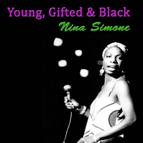So many songs are written about people who are not relatives of the writer, nor are they famous outside their own territory, yet they have done something that warrants a song to be written about them. This week’s track was written about Lorraine Hansberry, one of four children born in Chicago in 1930 and who, in her brief life became a Playwright.
When she was eight, her father, who was a successful real estate broker, moved his family to a suburb on the south side of Chicago. It was a predominantly white area and the black Hanberry family were not best welcomed. Lorraine’s best known work was called A Raisin in the Sun, which was story of her family’s battle against the racial segregation she encountered in her new homeland area.
In 1951 she became a staff member at the Black newspaper called Freedom under the guidance of Paul Robeson. Whilst there she met and became close friends with Nina Simone. It was here in 1957 that she wrote A Raisin In the Sun. Two years later it was on Broadway and that achievement led to the first play written by an African-American woman to be produced on Broadway. Her next play, and as it turned out, her last, was called To Be Young, Gifted and Black which she never finished. Sadly Lorraine died of pancreatic cancer in January 1965 aged just 34.
The title of that unfinished work became a song that Nina Simone, along with Weldon Irving, wrote as a tribute to her. It could almost have been an autobiographical song for the lady born Eunice Kathleen Waymon. She was generally considered a child prodigy as she was playing the piano at the age of four and then studying classical music at the Juilliard School of Music in New York when she was in her last year of high school.
She recorded the song in 1970 for her album Blackgold, but at the time she didn’t publicise its story and so it was duly considered a Civil Rights anthem. What she did say in an interview at the time was, “Now, this song is not addressed, primarily to white people, though it does not put you down in any way, it simply ignores you,” she laughed. “My people need all the inspiration and love that they can get.”
Simone told an interviewer in 1997 that from the very beginning her dream was to be a concert pianist. She said “It never occurred to me that I’d be playing to audiences that were talking and drinking and carrying on. If they didn’t want to listen, they could go the hell home.” She was also angered when critics labelled her a jazz singer. “To most white people, jazz means dirt and that’s not what I play,” she retorted. She was passionate about music in all forms. She performed songs by Kurt Weill and Bertolt Brecht as readily as folk songs, spirituals and songs from the blues. She did not tolerate comparisons to other artists and was especially incensed by critics citing similarities to Billie Holiday, “They only compare me to her because we were both black. They never compared me to Maria Callas and I’m more of a diva like her than anybody else.”
Nina’s version, which featured Boris Gardner on bass failed to chart in the UK and only reached number 76 stateside. The big UK hit version was a top five hit in 1970 for Bob Andy and Marcia Griffiths as Bob & Marcia. They dropped the ‘To Be’ from the title and became just, Young Gifted and Black. Both were successful solo reggae singers in their native Jamaica but it was producer Harry J who brought them together to record their reggae version of it. The following year they had one follow up with the number 11 hit Pied Piper. After that, both resumed their own careers with Marcia later becoming a member of Bob Marley’s Wailers.
Nina Simone became disgusted with the music industry and with the racism in the United States. Her first hand experience of this was at her first ever public recital when her parents were asked to leave the first row to accommodate white folks. She left the States in the very early seventies saying, “I didn’t like America. I never did . . . I think they’ll sell themselves, their souls, their brothers, sisters, and their mothers for money. She moved around a bit living for brief spells in Liberia, Switzerland, Paris, Belgium, and The Netherlands. Her final home was in the south of France where she remained until her death in 2003 aged 70. She chose to live in exile from the country that did not give her respect – both as an artist and as a human being – and found herself revered where she headlined jazz festivals. In her later years she said, “I want to be remembered as a diva, from beginning to end, who never compromised in what she felt about racism and how the world should be, and who, to the end of her days, constantly stayed the same.”
